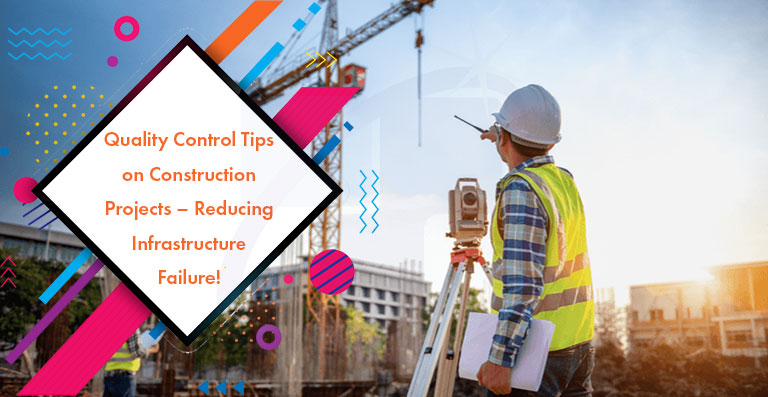Quality Control Tips on Construction Projects – Reducing Infrastructure Failure!

Overview
The globe is witnessing a lot of infrastructure mishaps due to lack of adherence of quality control procedure while the whole process from conceptualization to construction and post construction phase. Despite of innovations in the software technologies, the quality of Architectural Construction Drawings and Documents have been declining and the complexity of design is increasing. Documentation of quality processes and procedures and use of checklists are common practices among successful construction companies. There are several drivers that contribute to the need to provide documentation and quality processes.
Steps to implement & improve quality control procedure for construction projects:
- Training Rotations and Staff Training
One of the first steps to quality in design is to have quality people trained well in core competencies. Many companies have innovative training and mentoring programs for new staff as well as continuing education and training in quality processes for existing staff.
- Reporting and Feedback
Quality processes do not begin and end with review of designs and contract documents. Feedback and reporting are needed to ensure quality in future projects and instil effectiveness and efficiency into processes. Best practices and successful solutions within agencies should be recognized, reported, awarded, and incorporated into existing processes.
- Regularly Scheduled Meetings Across Disciplines
Almost all construction companies schedule milestone meetings to discuss issues with design projects, often at 30-60-90% complete reviews and for final reviews. However, some with standout quality programs take the extra step to make sure all disciplines relevant to a project are involved in the early stages. For example, it is often beneficial to have construction engineering staff involved as early as the scoping phase and throughout the design. This helps prevent constructability issues from arising at a time when design changes cannot be easily made. QA does not just occur at the end of the product production. It should take place throughout the design process with all relevant parties involved.
- Relationships Between Consultants and the Departments
Keeping lines of communication open and maintaining relationships between consultants and DOTs is always important in producing quality plans. Of course, one way to do this is through regularly scheduled project-specific meetings and early involvement of all disciplines, as mentioned above. However, many have come up with innovation solutions to maintaining good relationships between consultants and DOT staff.
- Value Engineering
VE is not a new process and is a requirement of many. However, VE processes can be valuable to quality processes when feedback is used to make design processes more effective and efficient.
- Third Party Reviews
Often, we may need to hire consultants or outsource documentation and Drafting Services to create designs and do third-party reviews of design work. These reviews are done for specialty projects or when DOTs do not have sufficient expertise or staff to meet deadlines. Some states have moved to an even more aggressive use of third-party reviews to add an extra layer of QC.
- Plan Review and Signoffs
One other practice followed by many other companies is the use of title blocks on plan sheets that clearly define the designer and the reviewers, as well as include signoffs for when reviews are completed. This is an easily implemented, simple task that ensures that designers and reviewers take responsibility for the quality of the plans. Plan signoffs or PE stampings are done at many different levels, including signoffs on the original design, for reviews, and even for design changes that are done in construction.
- Single-Point Data Systems
Many are moving to single-point data systems where multiple users and disciplines can look at and analyse documents to determine problem areas and make improvements in processes. It seems that most of the construction companies allow for document management and give the ability to analyse trends in design and construction processes. These data systems can be great contributors to the overall quality of projects.
- Documentation
When talking about documentation, the important thing to note is that more is not always better (i.e., the amount of checklists, manuals, and processes does not necessarily correlate with the level of quality). That being said, it is often true, that “success is being organized,” and documentation provides a level of organization and consistency in design that is important to quality efforts.
- Construction Feedback and Post-Construction Reviews
Many states that have successful quality programs have realized the need to involve construction staff early on in each project to ensure that projects are “bid-able” and “buildable.” Another very important contribution of construction staff is feedback on the bid-ability and construction phase processes.
Conclusion
Finally, there are some review and approval practices which can be used by the construction companies in their QC/ QA programs:
- Checklists outlining processes for designers, reviewers, and contract document compilation are used for each phase of project development.
- Consultants should be rated or graded.
- Decisions about the amount and type of review are made on a risk-based scale, taking into consideration the type and size of the project to determine the depth of the review.
- Although VE is done by all, successful ones evaluate the outcomes of these processes and use it as lessons learned feedback for future designs.
- Third-party consultant reviews are done for specialty projects or when DOTs do not have sufficient expertise or staff to meet deadlines.
- Plan signoffs or professional engineer (PE) stampings are done at many different levels, including signoffs on original design, review, and even for design changes that are done in construction.
- Most of the construction companies are moving to single-point data systems where multiple users and disciplines can look at and analyse documents to determine problem areas and make improvements in processes.
These are the few steps that the companies should take into consideration while the whole phase of any construction projects. Each design firm should must come up with their own quality control procedure appropriate to its practice.
